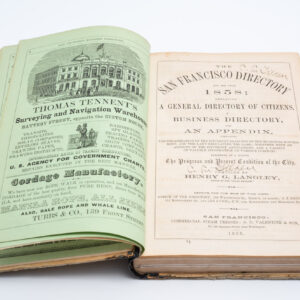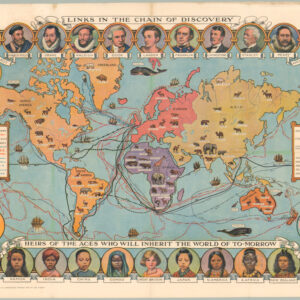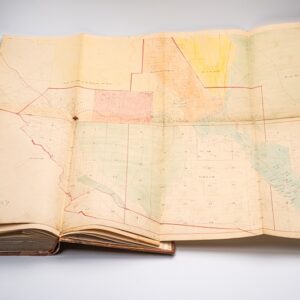First octavo edition of Cook’s Third Voyage account, with numerous iconic plates and a large chart of the world as discovered by the 18th century’s most famous explorer.
A Voyage to the Pacific Ocean; Undertaken by Command of his Majesty, for Making Discoveries in the Northern Hemisphere…1784.
Out of stock
Description
The first octavo edition of Cook’s Third Voyage to discover a northwest passage linking the Atlantic and Pacific Oceans. It is abridged, without all the technical nautical details found in the preceding quarto edition, but usually preferred by readers because “the work reads more like an adventure” (Hill).
The Third Voyage was marked by extensive Pacific exploration and valuable scientific contributions but also by the unfortunate death of its commander. It was crucial in further mapping the Pacific and understanding its manifold cultures. We find William Bligh, James Burney, James Colnett, and George Vancouver among the many significant crew members. John Webber was the expedition artist and the man behind the iconic views published in these four volumes. The voyage included stops at Kerguelen Island, Tasmania, New Zealand, and the Cook, Tonga, and Society Islands. The expedition was also accredited with discovering the Hawaiian archipelago, which Cook named the Sandwich Isles and considered his most important discovery.
Context is Everything
Captain James Cook’s Third Voyage, launched in 1776, was one of the most crucial expeditions of the Age of Exploration. Its primary objective was to search for the elusive Northwest Passage, a navigable route connecting the Atlantic and Pacific Oceans. The voyage was also tasked with furthering geographical knowledge and making scientific discoveries, as had been the hallmark of Cook’s previous journeys.
Cook was entrusted with the command of two vessels, the Resolution and the Discovery. The Resolution had also participated in Cook’s second voyage, where it had proved to be a reliable and sturdy ship. The Discovery, on the other hand, was a newly built vessel specifically designed for research and exploration.
Even though the Third Voyage took place during the height of the American Revolution, in which France sided with the United States, the scientific nature of this particular expedition caused the various governments to exempt Cook’s vessels from capture or attack.
Pacific Exploration and Discoveries
The expedition sailed through the Pacific Ocean, making numerous significant discoveries en route. Cook and his crew reached Tahiti, where they continued their study of indigenous cultures and scientific observations. From there, they explored the islands of the South Pacific, charting the coasts of Tonga, Fiji, and Vanuatu, thus contributing significantly to a more accurate and comprehensive knowledge of the region.
Following these extensive Pacific explorations, the expedition then headed north in a determined effort to find the Northwest Passage. They explored the west coast of North America, reaching as far north as the Bering Strait, but icy conditions thwarted their quest, and it was deemed that a navigable passage through the Arctic did not exist.
The Demise of Captain Cook
Having come face to face with the impenetrable Arctic ice, Cook and his crew turned back south, returning to Hawaii in January 1779. Tragically, the new encounter with the native Hawaiians would have a fatal outcome for the expedition’s legendary leader. Cook had landed his ships in Kealakekua Bay on the island of Hawaii. Relations between the crew and native Hawaiians had been relatively amicable during previous visits, but tensions quickly escalated this time. On February 14, an incident occurred in which a longboat was stolen from the Resolution by Hawaiians. In an attempt to retrieve it, Cook and a group of his men waded ashore. As they attempted to negotiate the boat’s return, a dispute quickly turned violent.
During the altercation, Cook and four of his marines were killed. The exact details of his death are somewhat unclear, but it is widely believed that he was struck by Hawaiians in the conflict. Cook’s death marked a tragic end to a distinguished career of exploration and discovery. The surviving crew members buried his remains at sea with full honors. The team pressed on, but Cook’s death was a profound loss to the expedition and the world of exploration.
Aftermath and Legacy
Following Cook’s death, his second-in-command, Charles Clerke, assumed leadership of the mission. But after six months, Clerke also perished. The captaincy then passed to John Gore, who, despite the challenges, continued the expedition before returning to England in October 1780.
Cook’s Third Voyage might not have achieved its primary goal of finding the Northwest Passage, but it significantly contributed to understanding the Pacific and its peoples. His meticulous mapping of previously uncharted territories and his dedication to scientific observations solidified his status as one of the most prominent explorers in history.
Cartographer(s):
Captain James Cook (1728-1779) was a British explorer and navigator renowned for his groundbreaking voyages during the 18th century. Born in Marton, England, Cook began his career in the Royal Navy, where he quickly distinguished himself for his navigational skills and dedication to scientific exploration. His first major voyage, aboard the HMS Endeavour, set sail in 1768 with the primary goal of observing the transit of Venus in the South Pacific. This journey led to the extensive mapping of the Pacific and the discovery of the eastern coast of Australia, which he named New South Wales. Cook’s second voyage, from 1772 to 1775, furthered his explorations of the southern hemisphere and contributed significantly to the world’s understanding of the Pacific Ocean.
Cook’s third and final voyage, which began in 1776, aimed to locate the elusive Northwest Passage and further explore the Pacific. Though he was unable to find the passage, this expedition added substantial knowledge to the geography of the South Pacific, the west coast of North America, and Alaska. Tragically, Cook’s life was cut short during this voyage when he was killed in a conflict with native Hawaiians in 1779. Despite his untimely death, Cook’s legacy endures through his invaluable contributions to understanding the world’s geography and the cultures he encountered during his expeditions, solidifying his status as one of history’s greatest explorers.
Condition Description
Expertly restored. Complete: Volumes I-IV: frontispiece of James Cook, 4, General chart, V-VII, V-XII, 370 pp. 17 plates, + XII, 359pp, 11 plates, + XII, 400pp, 16 plates, 1 map. + XII, 310, 2, 36 (Index), 24 (subscribers list), 2 (directions for the bookbinder), 6 (publishers catalog), 4 plates. Book: 21 by 13.5 cm (8.2 x 5.3 in); Map: 60.5 by 46 cm (23.8 x 18 in).
Each of the four volumes comes in a custom-made archival box produced by the specialist firm KLUG Conservation in Germany.
References




